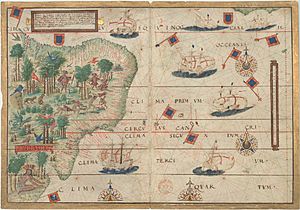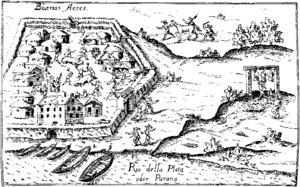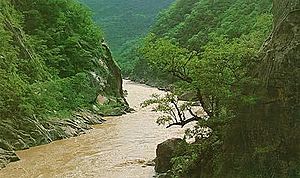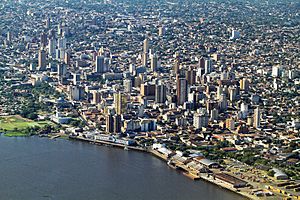Sierra de la Plata facts for kids
The Sierra de la Plata (meaning "Mountain of Silver") was a famous legend about a huge mountain made of silver. People believed it was hidden deep inside South America. The story started in the early 1500s. Some shipwrecked sailors heard tales from local people about a "White King" who ruled a land with a mountain of silver.
One of the first Europeans to look for this mountain was Aleixo Garcia. He traveled across almost the entire continent! Sadly, he was attacked and killed on his way back. But the survivors brought back some valuable metals. This made the legend seem even more real.
Many explorers tried to find the Sierra de la Plata. They didn't find the mythical mountain, but their journeys helped the Spanish explore a lot of South America. They also founded important cities like Buenos Aires and Asunción. Later, these lands became part of a big Spanish area called the Viceroyalty of the Río de la Plata.
In 1545, Spanish explorers found the Cerro Rico de Potosí in Bolivia. This was a real mountain with a huge amount of silver! It's possible that this real silver mountain was the basis for the legend of the Sierra de la Plata.
Even today, the river Río de la Plata (which means "Silver River") and the country of Argentina (whose name comes from the Latin word for "silver") are named after this exciting legend.
Contents
How the Legend Began
Juan Díaz de Solís's Journey

The story of the White King and the Sierra de la Plata started with the trips of Juan Díaz de Solís. He explored the coast of South America. In 1512, Solís found a huge river mouth, the Río de la Plata. Another explorer, Amerigo Vespucci, had called it the River Jordan. Local people called it Paranaguazu, meaning "river like the sea."
Solís called it the Mar Dulce, or "Freshwater Sea," because it was so big. He thought it might be a way to get from the Atlantic to the Pacific. Solís went back to Spain to claim the land. In 1516, he returned as Captain General. But when he and his group landed, they were attacked by Guaranís and killed. His crew quickly sailed back to Spain.
Aleixo Garcia's Adventure
On their way back to Europe, one of Solís's ships crashed near Santa Catarina Island in Brazil. Eighteen men were left stranded. One of them was a Portuguese explorer named Aleixo Garcia. He became friends with the local Tupí-Guaraní people. From them, he heard about a great mountain of shiny metals far inland.
Garcia decided to find the Sierra de la Plata. He left Santa Catarina with other castaways and a large group of local people. They crossed most of South America. They reached the high plains of the Andes. This was supposedly the home of the White King, whose throne was covered in silver.
After taking some valuable pieces, the explorers headed back to the coast. But Aleixo Garcia and the other Europeans were killed in an attack by the Payaguá tribe. The few Tupí-Guaranís who escaped told their story. They showed off the silver pieces they had gotten from the White King's land.
The Search for the Silver Mountain
Sebastian Cabot's Quest
In 1526, an explorer from Venice named Sebastian Cabot left Spain. His goal was to reach the Molucca Islands in Indonesia. He planned to go through the Straits of Magellan. But during a stop in Brazil, he heard the stories about a land rich in precious metals. People said you could reach it by a huge river to the south. This river later became known as the Río de la Plata because it was thought to be the way to the treasure.
Cabot was so excited by the legend that he changed his plans. He decided to find the Sierra de la Plata. He hoped the king would forgive him if he found enough silver.
On Santa Catarina Island, some of the shipwrecked sailors confirmed the stories. They told Cabot about Aleixo Garcia's trip and showed him the metals. Cabot sailed to the Río de la Plata. There, he met Francisco del Puerto. He was the only survivor from Solís's landing party. Del Puerto was living with the Guaranís. He also said the legend was true and offered to be a guide.
Cabot's group went into the Río de la Plata. They built a fort called Sancti Spiritu in 1527. This was the first European settlement in the area. It would be a base for trips to the land of the White King. The group faced hunger and sickness. They continued upriver. They traded colored glass for food with the Timbús. But Cabot thought he was cheated. He ordered his men to kill them, burn their homes, and take their food.
Later, Cabot met Diego García. García was also supposed to go to the Moluccas but had changed his mind when he heard the silver stories. After a small argument, they decided to work together. Cabot was in charge.
Captain Francisco César explored the local area. He came back with a rumor of a great city full of riches. This city became known as the Ciudad de los Césares.
But Cabot's expedition ended badly. While he and García were away, local people attacked and destroyed Fort Sancti Spiritu. Many of their men were killed. With low spirits, little food, and few supplies, Cabot and his crew had to give up. They returned to Europe.
Pedro de Mendoza's Large Expedition
In 1534, King Charles I allowed Pedro de Mendoza to "conquer and settle the lands around the Solís River, also called the Plate." Mendoza set out with fourteen ships and about 1,200 men. It was the biggest expedition ever to leave Europe for America at that time.
In 1536, Pedro de Mendoza founded the port of Santa María de los Buenos Ayres. It was probably located where Parque Lezama is today. There wasn't enough food for so many people. The Spanish treated the local Querandís badly, so they stopped providing food. Mendoza sent out two groups to find food. One went to Brazil. The other, led by Juan de Ayolas, went up the Paraná River.
Meanwhile, Mendoza ordered his brother Diego to fight the Querandís. The battle was a failure. Diego de Mendoza was killed. The Querandís then began a long attack on Buenos Aires. The settlers had no supplies. They started to eat their horses and even their dead.
Finally, the Querandís left. A few days later, Juan de Ayolas's group returned. They had built a fort called Corpus Christi upriver. They had also met local people who talked about the Sierra de la Plata. Pedro de Mendoza decided to go to the fort with Ayolas and about 400 men.
During the trip, about 200 men died from sickness and hunger. When they reached Corpus Christi, Mendoza saw on Cabot's map that they were still far from their goal. Pedro de Mendoza died at sea on June 23, 1537.
Juan de Ayolas's Journey Inland
Before Pedro de Mendoza left Buenos Aires, he sent Juan de Salazar Espinosa upriver to find Ayolas. On August 15, 1537, Espinosa built the fort of Nuestra Señora de la Asunción. Today, this is Asunción, Paraguay.
Meanwhile, Juan de Ayolas was further up the Paraguay River. He met one of Aleixo Garcia's old friends. This person told him how hard the journey had been because of all the gold and silver they carried. Ayolas decided to build a port called Candelaria. He left Domingo Martínez de Irala in charge and went on an overland trip with 130 soldiers. After some time, with no news of Ayolas, Irala went back downriver to Asunción.
However, Juan de Ayolas's group had reached a mountainous area where precious metals were mined. On his way back, his group was attacked by local people. Before he reached the Paraguay River, he told his men to bury most of the treasure. When he returned, he found Candelaria empty. He accepted an invitation from the Payaguas to rest in their village. But a fight broke out, and almost the entire group was killed, including Juan de Ayolas.
After this, Domingo Martínez de Irala became the new leader. He decided to make Asunción the main base for the conquest. He ordered the settlers in Buenos Aires to move to Asunción. But their newly planted corn was growing well, and they refused to move. Six months later, Irala went to Buenos Aires to force them. The first settlement at Buenos Aires was finally destroyed and abandoned in 1541.
Álvar Núñez Cabeza de Vaca's Arrival

While Irala was getting ready for his trip to the Sierra de la Plata, Spain chose Álvar Núñez Cabeza de Vaca as the new official leader. Cabeza de Vaca was known for living among Native Americans in what is now Texas and Mexico. He decided to cross Paraguay on foot instead of by boat. In October 1541, his group left Santa Catalina. They crossed jungles, mountains, and rivers to reach Asunción. In January 1542, they passed Iguazú Falls. On March 11, 1542, they reached Asunción and met Domingo Martínez de Irala.
Cabeza de Vaca didn't get along with the settlers in Asunción. He called the village a "Moorish paradise" because each settler had taken many local women as wives.
Soon, Cabeza de Vaca started to plan his own trip to the lands of the White King. He sent Irala up the Paraguay River to see if it led to the Sierra de la Plata. Irala reached La Gaiba Lake in the Pantanal region. There, he founded the Puerto de los Reyes. In September 1543, Cabeza de Vaca led his own trip through the forest. But sickness and arguments with his officers, mostly Irala's men, made him give up. He returned to Asunción.
His authority was weakened, and the settlers didn't like him. So, on April 25, 1544, Irala's men took Cabeza de Vaca prisoner. Eleven months later, he was sent to Spain. During the trip, a big storm broke out. The sailors thought it was a sign from God, so they freed all their prisoners. In Spain, Cabeza de Vaca complained about the settlers' actions to the court. But the case was never solved, and he never returned to the Americas.
Domingo Martínez de Irala's Rule
With his power confirmed, Domingo Martínez de Irala organized a trip with 300 Spanish men and 3,000 local men to find the Sierra de la Plata. After some battles, Irala's men reached a tribe called Macasís. These people immediately spoke to them in Spanish. They told Irala that their lord was Pedro Anzures, meaning they were in another Spanish area. Irala sent a group to speak with the governor of Peru, Pedro de la Gasca. The governor ordered Irala's group to go no further. So, they had to return to Asunción.
Irala organized several other trips to legendary places like the "Land of Riches," the "Lake of El Dorado," and "Paititi." All these trips failed. They cost many lives and a lot of supplies. Meanwhile, the king named Juan de Sanabria as the new leader for the region. But he died before he could leave. His son, Diego, took his place but stayed in Europe.
Finally, the king decided to make Irala's power official. As Irala was planning his next trip, a royal messenger arrived in Asunción. He told Irala that he was named governor of the Governorate of New Andalusia. He was given clear orders not to lead any more expeditions. With Buenos Aires destroyed and the Sierra de la Plata under another Spanish area, Paraguay became very isolated under Irala. He died in October 1556 at the age of 70.
Cerro Rico de Potosí: The Real Silver Mountain
The legend of the Sierra de la Plata probably refers to the Cerro Rico de Potosí in Bolivia. The "White King" might have been the Inca ruler Huayna Cápac. When Aleixo Garcia explored the area and found precious metals in the early 1500s, Spain and Portugal had only just started settling the coasts. Neither country knew about the powerful Inca Empire until Francisco Pizarro found it in 1528.
King Charles I tried to solve arguments between explorers by dividing South America into several areas. These included New Castile (under Francisco Pizarro), New Toledo (under Diego de Almagro), and New Andalusia (under Pedro de Mendoza). Of these, it was Almagro's men who first found the Cerro Rico de Potosí.
Images for kids
See also
 In Spanish: Sierra de la Plata para niños
In Spanish: Sierra de la Plata para niños
- Antillia
- City of the Caesars (Ciudad de los Césares)
- El Dorado
- La Plata Mountains
- Quivira and Cíbola
- Paititi






